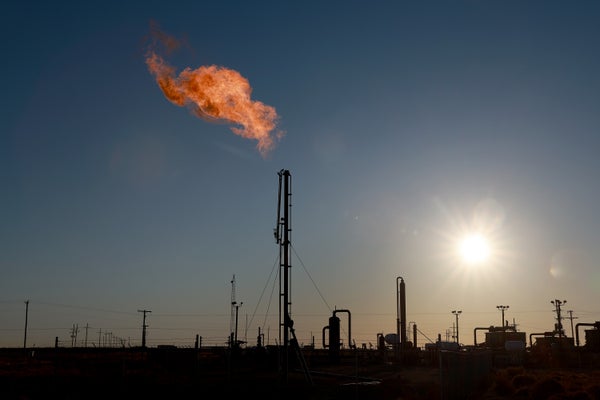August 19, 2024
2 Time required to read
New satellite tracks methane super-emitter
Tanager-1 is the first in a series of satellites aimed at identifying major sources of emissions of carbon dioxide and methane, the main greenhouse gases.

Natural gas is flared during an oil drilling operation in the Permian Basin oil fields in Midland, Texas, March 12, 2022.
Privacy Policy A new satellite capable of pinpointing the exact source of huge greenhouse gas emissions was launched from California on Friday, adding another tool to the global effort to tackle the causes of global warming.
Tanager-1, launched alongside SpaceX’s Transporter-11, can detect major sources of carbon dioxide and methane, a gas that is 80 times more effective at trapping heat in the atmosphere than carbon dioxide. The probe was deployed by a coalition of Carbon Mapper, Planet Lab, and NASA’s Jet Propulsion Laboratory, and was funded by organizations including Bloomberg Philanthropies and the Children’s Investment Fund Foundation.
Carbon Mapper says the satellite will focus on facilities that emit more than 100 kilograms of methane per hour and help pinpoint the source of those emissions, like pipeline leaks or power plant flames. It’s the first of many similar satellites the nonprofit hopes to launch, and the resulting data will be made publicly available online.
Supporting science journalism
If you enjoyed this article, please support our award-winning journalism. Subscribe. By purchasing a subscription, you help ensure a future of influential stories about the discoveries and ideas shaping the world today.
Tanager-1 is seen as a complement to MethaneSAT, a satellite backed by the Environmental Defense Fund and Google, which will help locate and quantify emissions over larger areas, such as entire oil and gas basins.
Carbon Mapper co-founder and CEO Riley Duren likened Tanager 1 to a telephoto lens designed to zoom in and pinpoint emissions sources within 100 feet, making it easier to spot super-emission sources that might go undetected.
“Superemitters are potentially easy targets for action,” Duren said. “There are relatively few of them. And if you know where they are, you can detect them and notify facility operators and regulators, which increases the likelihood of action being taken, especially in the case of a malfunction.”
Many countries see cutting energy-related emissions of methane as one of the fastest ways to prevent global temperatures from rising. Methane is more potent than carbon dioxide but stays in the atmosphere for a shorter time.
More than 150 countries have signed a pledge to collectively reduce methane emissions by 30% by 2030, and at last year’s COP28 climate change conference, dozens of major oil and gas companies agreed to reduce methane emissions to near zero by 2030 and end routine flaring.
The White House included the Carbon Mapper satellite program in a recent fact sheet outlining the administration’s support for efforts to curb climate super-pollutants.
The Tanager-1 satellite will prioritize areas where methane emissions are known to occur, such as oil and gas fields, refineries, landfills, etc. Carbon Mapper says this information can help companies identify and repair leaks, and help countries choose to import natural gas from sources with the lowest emissions.
The nonprofit also sees itself as serving as a watchdog to help researchers, regulators and environmental groups determine whether industry is living up to its emissions-cutting pledges.
“Increasing confidence in the actual methane leak rates and strengths in the global supply chain can help put pressure on oil and gas producing countries to reduce their methane emissions,” Duren said.
Source E&E News Posted with permission from POLITICO, LLC. Copyright 2024. E&E News delivers news that matters to energy and environmental professionals.

